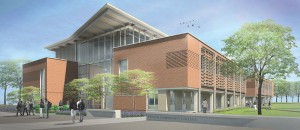Fall River, MA Bristol Community College’s John J. Sbrega Health and Science Building, represents the translation of basic science to its application in the health professions. The building accommodates instructional labs for biology, chemistry, nursing, clinical laboratory science, medical assisting, and dental hygiene, which has an important outreach function in providing care to underserved populations.
A shared atrium is envisioned as both a ‘learning commons’ and student living room, inviting a broader set of users to the building as a place to study and learn in more informal ways, while also encouraging unplanned interactions among students, faculty and staff. The walls separating labs from the atrium are glazed, allowing for views into the labs and putting ‘science on display’.
The initial basis of design called for a ‘high-performance’ building meeting the requirements of Executive Order 484 – Leading By Example. While on hold awaiting funding, the College intensified its ACUPCC commitment to carbon neutrality, initiating plans to build a 3.2 megawatt solar array. This new context necessitated a reassessment the original design, which would have used half of the power generated by the solar array and enough natural gas to heat two hundred homes. The team agreed to develop a ZNE design. With few precedents, the question was: how to achieve ZNE for an energy-dense program in a cold climate?
Ultimately, a combination of strategies was developed: reduced lighting and plug loads, a high-performance envelope, natural ventilation systems, wider indoor temperature range, localized cooling, filtration fume hoods, reduced air changes, enthalpy wheel heat recovery, and a hybrid-source heat pump system. The building is projected to use less than 20% of the new array and no fossil fuels for heating and cooling.
Significantly, the ZNE design was achieved without increasing the budget. The building will serve as an important benchmark for future campus development and a model for other institutions.







